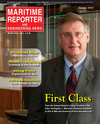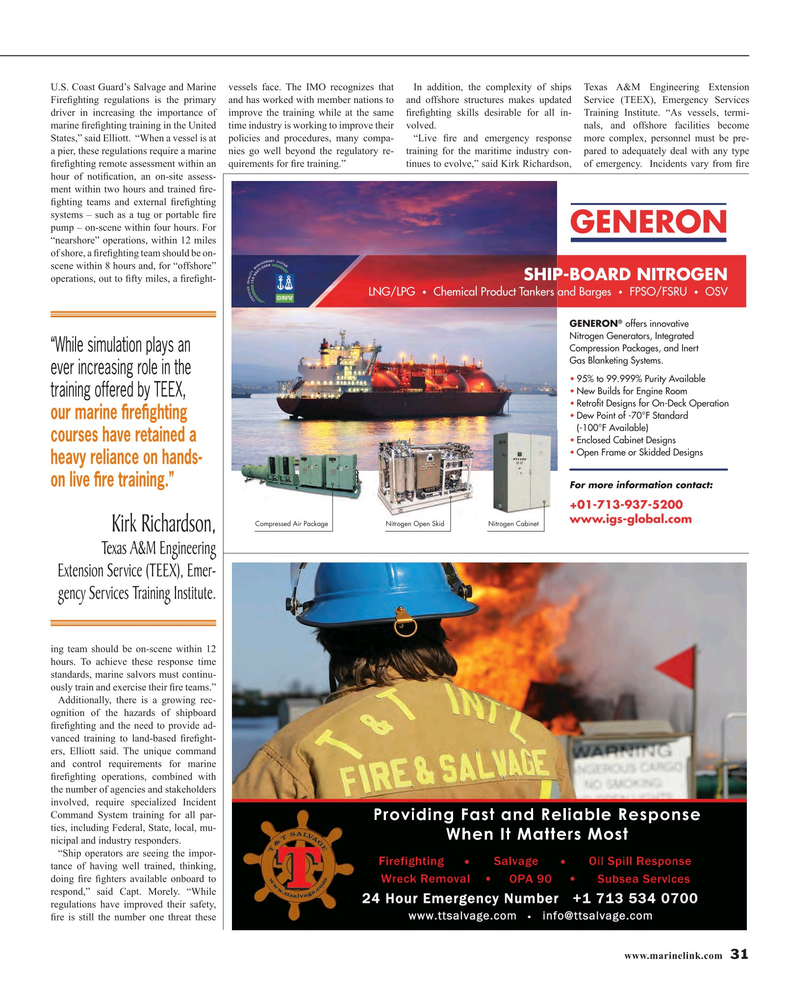
Page 31: of Maritime Reporter Magazine (October 2015)
Marine Design Annual
Read this page in Pdf, Flash or Html5 edition of October 2015 Maritime Reporter Magazine
U.S. Coast Guard’s Salvage and Marine vessels face. The IMO recognizes that In addition, the complexity of ships Texas A&M Engineering Extension
Fire? ghting regulations is the primary and has worked with member nations to and offshore structures makes updated Service (TEEX), Emergency Services driver in increasing the importance of improve the training while at the same ? re? ghting skills desirable for all in- Training Institute. “As vessels, termi- marine ? re? ghting training in the United time industry is working to improve their volved. nals, and offshore facilities become
States,” said Elliott. “When a vessel is at policies and procedures, many compa- “Live ? re and emergency response more complex, personnel must be pre- a pier, these regulations require a marine nies go well beyond the regulatory re- training for the maritime industry con- pared to adequately deal with any type ? re? ghting remote assessment within an quirements for ? re training.” tinues to evolve,” said Kirk Richardson, of emergency. Incidents vary from ? re hour of noti? cation, an on-site assess- ment within two hours and trained ? re- ? ghting teams and external ? re? ghting systems – such as a tug or portable ? re pump – on-scene within four hours. For “nearshore” operations, within 12 miles of shore, a ? re? ghting team should be on- scene within 8 hours and, for “offshore”
SHIP-BOARD NITROGEN operations, out to ? fty miles, a ? re? ght-
LNG/LPG Chemical Product Tankers and Barges FPSO/FSRU OSV? ? ?
®
GENERON offers innovative
Nitrogen Generators, Integrated
Compression Packages, and Inert “While simulation plays an
Gas Blanketing Systems.
ever increasing role in the ? 95% to 99.999% Purity Available ? New Builds for Engine Room training offered by TEEX, ? Retro?t Designs for On-Deck Operation ? Dew Point of -70°F Standard our marine ? re? ghting (-100°F Available) courses have retained a ? Enclosed Cabinet Designs ? Open Frame or Skidded Designs heavy reliance on hands- on live ? re training.”
For more information contact: +01-713-937-5200 www.igs-global.com
Nitrogen Open Skid Compressed Air Package Nitrogen Cabinet
Kirk Richardson,
Texas A&M Engineering
Extension Service (TEEX), Emer- gency Services Training Institute.
ing team should be on-scene within 12 hours. To achieve these response time standards, marine salvors must continu- ously train and exercise their ? re teams.”
Additionally, there is a growing rec- ognition of the hazards of shipboard ? re? ghting and the need to provide ad- vanced training to land-based ? re? ght- ers, Elliott said. The unique command and control requirements for marine ? re? ghting operations, combined with the number of agencies and stakeholders involved, require specialized Incident
Command System training for all par- ties, including Federal, State, local, mu- nicipal and industry responders. “Ship operators are seeing the impor- tance of having well trained, thinking, doing ? re ? ghters available onboard to respond,” said Capt. Morely. “While regulations have improved their safety, ? re is still the number one threat these www.marinelink.com 31
MR #10 (26-33).indd 31 10/4/2015 8:46:04 PM

 30
30

 32
32
